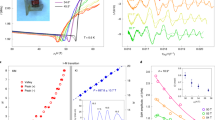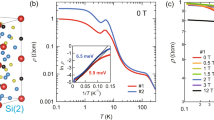Abstract
Quantum oscillations in transport and thermodynamic parameters at high magnetic fields are an unambiguous signature of the Fermi surface, the defining characteristic of a metal. Recent observations of quantum oscillations in insulating SmB6 and YbB12, therefore, have been a big surprise—despite the large charge gap inferred from the insulating behaviour of the resistivity, these compounds seemingly host a Fermi surface at high magnetic fields. However, the nature of the ground state in zero field has been little explored. Here, we report the use of low-temperature heat-transport measurements to discover gapless, itinerant, charge-neutral excitations in the ground state of YbB12. At zero field, sizeable linear temperature-dependent terms in the heat capacity and thermal conductivity are clearly resolved in the zero-temperature limit, indicating the presence of gapless fermionic excitations with an itinerant character. Remarkably, linear temperature-dependent thermal conductivity leads to a spectacular violation of the Wiedemann–Franz law: the Lorenz ratio is 104–105 times larger than that expected in conventional metals, indicating that YbB12 is a charge insulator and a thermal metal. Moreover, we find that these fermions couple to magnetic fields, despite their charge neutrality. Our findings expose novel quasiparticles in this unconventional quantum state.
This is a preview of subscription content, access via your institution
Access options
Access Nature and 54 other Nature Portfolio journals
Get Nature+, our best-value online-access subscription
$29.99 / 30 days
cancel any time
Subscribe to this journal
Receive 12 print issues and online access
$209.00 per year
only $17.42 per issue
Buy this article
- Purchase on Springer Link
- Instant access to full article PDF
Prices may be subject to local taxes which are calculated during checkout




Similar content being viewed by others
Data availability
The data that support the plots within this paper and other findings of this study are available from the corresponding authors upon reasonable request.
References
Tsunetsugu, H., Sigrist, M. & Ueda, M. The ground-state phase diagram of the one-dimensional Kondo lattice model. Rev. Mod. Phys. 69, 809–863 (1997).
Riseborough, P. S. Heavy fermion semiconductors. Adv. Phys. 49, 257–320 (2000).
Dzero, M., Sun, K., Galitski, V. & Coleman, P. Topological Kondo insulators. Phys. Rev. Lett. 104, 106408 (2010).
Weng, H., Zhao, J., Wang, Z., Fang, Z. & Dai, X. Topological crystalline Kondo insulator in mixed valence ytterbium borides. Phys. Rev. Lett. 112, 016403 (2014).
Xu, N. et al. Direct observation of the spin texture in SmB6 as evidence of the topological Kondo insulator. Nat. Commun. 5, 4566 (2014).
Hagiwara, K. et al. Surface Kondo effect and non-trivial metallic state of the Kondo insulator YbB12. Nat. Commun. 7, 12690 (2016).
Li, G. et al. Two-dimensional Fermi surfaces in Kondo insulator SmB6. Science 346, 1208–1212 (2014).
Tan, B. S. et al. Unconventional Fermi surface in an insulating state. Science 349, 287–290 (2015).
Hartstein, M. et al. Fermi surface in the absence of a Fermi liquid in the Kondo insulator SmB6. Nat. Phys. 14, 166–172 (2018).
Xiang, Z. et al. Bulk rotational symmetry breaking in Kondo insulator SmB6. Phys. Rev. X 7, 031054 (2017).
Knolle, J. & Cooper, N. R. Quantum oscillations without a Fermi surface and the anomalous de Haas–van Alphen effect. Phys. Rev. Lett. 115, 146401 (2015).
Knolle, J. & Cooper, N. R. Excitons in topological Kondo insulators: theory of thermodynamic and transport anomalies in SmB6. Phys. Rev. Lett. 118, 096604 (2017).
Zhang, L., Song, X.-Y. & Wang, F. Quantum oscillation in narrow-gap topological insulators. Phys. Rev. Lett. 116, 046404 (2016).
Baskaran, G. Majorana Fermi sea in insulating SmB6: a proposal and a theory of quantum oscillation in Kondo insulators. Preprint at https://arxiv.org/abs/1507.03477 (2015).
Erten, O., Chang, P.-Y., Coleman, P. & Tsvelik, A. M. Skyrme insulators: insulators at the brink of superconductivity. Phys. Rev. Lett. 119, 057603 (2017).
Chowdhury, D., Sodemann, I. & Sentil, T. Mixed-valence insulators with neutral Fermi-surfaces. Nat. Commun. 9, 1766 (2018).
Sodemann, I., Chowdhury, D. & Sentil, T. Quantum oscillations in insulators with neutral Fermi surfaces. Phys. Rev. B 97, 045152 (2018).
Shen, H. & Fu, L. Quantum oscillation from in-gap states and non-Hermitian Landau level problem. Phys. Rev. Lett. 121, 026403 (2018).
Yoshida, T., Peters, R. & Kawakami, N. Non-Hermitian perspective of the band structure in heavy-fermion systems. Phys. Rev. B 98, 035141 (2018).
Anderson, P. W., Halperin, B. I. & Varma, C. M. Anomalous low-temperature thermal properties of glasses and spin glasses. Philos. Mag. 25, 1–9 (1972).
Matsuda, Y., Izawa, K. & Vechter, I. Nodal structure of unconventional superconductors probed by angle resolved thermal transport measurements. J. Phys. Condens. Matter 18, R705–R752 (2006).
Xu, Y. et al. Bulk Fermi surface of charge-neutral excitations in SmB6 or not: a heat-transport study. Phys. Rev. Lett. 116, 246403 (2016).
Boulanger, M.-E. et al. Field-dependent heat transport in the Kondo insulator SmB6: phonons scattered by magnetic impurities. Phys. Rev. B 97, 245141 (2018).
Fuhrman, W. T. et al. Interaction driven subgap spin exciton in the Kondo insulator SmB6. Phys. Rev. Lett. 114, 036401 (2015).
Xiang, Z. et al. Quantum oscillations of electrical resistivity in an insulator. Science 362, 65–69 (2018).
Mignot, J.-M. et al. Evidence for short-range antiferromagnetic fluctuations in Kondo-insulating YbB12. Phys. Rev. Lett. 94, 247204 (2005).
Okawa, M. et al. Hybridization gap formation in the Kondo insulator YbB12 observed using time-resolved photoemission spectroscopy. Phys. Rev. B 92, 161108(R) (2015).
Ikushima, K. et al. 171Yb NMR in the Kondo semiconductor YbB12. Physica B 281-282, 274–275 (2000).
Yamaguchi, J. et al. Kondo lattice effects and the collapse of lattice coherence in Yb1−xLuxB12 studied by hard x-ray photoelectron spectroscopy. Phys. Rev. B 79, 125121 (2009).
Utsumi, Y. et al. Bulk and surface electronic properties of SmB6: a hard X-ray photoelectron spectroscopy study. Phys. Rev. B 96, 155130 (2017).
Cooley, J. C., Aronson, M. C., Fisk, Z. & Canfield, P. C. SmB6: Kondo insulator or exotic metal? Phys. Rev. Lett. 74, 1629–1632 (1995).
Terashima, T. T. et al. Magnetization process of the Kondo insulator YbB12 in ultrahigh magnetic fields. J. Phys. Soc. Jpn 86, 054710 (2017).
Nemkovski, K. S. et al. Lattice dynamics in the Kondo insulator YbB12. J. Solid State Chem. 179, 2895–2899 (2006).
Czopnik, A. et al. Low-temperature thermal properties of yttrium and lutetium dodecaborides. J. Phys. Condens. Matter 17, 5971–5985 (2005).
Grechnev, G. E. et al. Electronic structure and bulk properties of MB6 and MB12 borides. Low Temp. Phys. 34, 1167–1176 (2008).
Singleton, J. Band Theory and Electronic Properties of Solids (Oxford University Press, 2002).
Yamashita, M. et al. Highly mobile gapless excitations in a two-dimensional candidate quantum spin liquid. Science 328, 1246–1248 (2010).
Yamashita, S., Yamamoto, T., Nakazawa, Y., Tamura, M. & Kato, R. Gapless spin liquid of an organic triangular compound evidenced by thermodynamic measurements. Nat. Commun. 2, 275 (2011).
Watanabe, D. et al. Novel Pauli-paramagnetic quantum phase in a Mott insulator. Nat. Commun. 3, 2082 (2012).
Balents, L. Spin liquids in frustrated magnets. Nature 464, 199–208 (2010).
Motrunich, O. I. Orbital magnetic field effects in spin liquid with spinon Fermi sea: possible application to κ-(ET)2Cu2(CN)3. Phys. Rev. B 73, 155115 (2006).
Katsura, H., Nagaosa, N. & Lee, P. A. Theory of the thermal Hall effect in quantum magnets. Phys. Rev. Lett. 104, 066403 (2010).
Watanabe, D. et al. Emergence of nontrivial magnetic excitations in a spin-liquid state of kagomé volborthite. Proc. Natl Acad. Sci. USA 113, 8653–8657 (2016).
Iga, F., Shimizu, N. & Takabatake, T. Single crystal growth and physical properties of Kondo insulator YbB12. J. Magn. Magn. Mater. 177-181, 337–338 (1998).
Kohama, Y., Marcenat, C., Klein, T. & Jaime, M. AC measurement of heat capacity and magnetocaloric effect for pulsed magnetic fields. Rev. Sci. Instrum. 81, 104902 (2010).
Taylor, O. J., Carrington, A. & Schlueter, J. A. Specific-heat measurements of the gap structure of the organic superconductors κ-(ET)2Cu[N(CN)2]Br and κ-(ET)2Cu(NCS)2. Phys. Rev. Lett. 99, 057001 (2007).
Iga, F. et al. Kondo-semiconductor to Kondo-impurity transition in the heat capacity of Yb 1-xLuxB12. Physica B 259-261, 312–314 (1999).
Li, D. et al. Thermal conductivity of individual silicon nanowires. Appl. Phys. Lett. 83, 2934–2936 (2003).
Tavakoli, A. et al. Universality of thermal transport in amorphous nanowires at low temperatures. Phys. Rev. B 95, 165411 (2017).
Acknowledgements
We thank K. Behnia, D. Chowdhury, P. Coleman, J. Knolle, H. v. Löhneysen, E.-G. Moon, R. Peters, S. Sebastian, T. Senthil and L. Taillefer for fruitful discussions. This work was supported by Grants-in-Aid for Scientific Research (KAKENHI) (nos. 25220710, 15H02106, 15H03688, 16K13837, 18H01177, 18H01180 and 18H05227) and on Innovative Areas ‘Topological Material Science’ (no. 15H05852) from the Japan Society for the Promotion of Science (JSPS). This work at Michigan is mainly supported by the Office of Naval Research through the Young Investigator Prize under Award No. N00014-15-1-2382 (electrical transport characterization), by the National Science Foundation under Award No. DMR-1707620 (magnetization measurement) and by the National Science Foundation Major Research Instrumentation award under No. DMR-1428226 (the equipment of the electrical transport characterizations). The development of the torque magnetometry technique in intense magnetic fields was supported by the Department of Energy under Award No. DE-SC0008110. A portion of this work was performed at the NHMFL, which is supported by National Science Foundation Cooperative Agreement No. DMR-1644779, the Department of Energy and the State of Florida. J.S. thanks the Department of Energy for support from the BES programme ‘Science in 100 T’. The experiment at the NHMFL is funded in part by a QuantEmX grant from ICAM and the Gordon and Betty Moore Foundation through grant GBMF5305 to Z.X., T.A., L.C., C.T. and L.L. We are grateful for the assistance of T. Murphy, H. Baek, G. Jones, F. Balakirev, R. McDonald, J. Betts and J.-H. Park of the NHMFL.
Author information
Authors and Affiliations
Contributions
F.I. grew the high-quality single-crystalline samples. Y.S., Y.K., S.K. and H.M. performed the thermal transport measurements. T.T., S.K., O.T. and Y.Mizukami performed the heat capacity measurements. Z.X., L.C, T.A., C.T., J.S. and L.L. performed the high-field resistivity measurements. Y.S., Z.X., Y.K., T.T., S.K., H.M., Y.Mizukami, T.S., L.L. and Y.Matsuda analysed the data. Y.S., Y.K., T.S., J.S., L.L. and Y.Matsuda prepared the manuscript.
Corresponding authors
Ethics declarations
Competing interests
The authors declare no competing interests.
Additional information
Publisher’s note: Springer Nature remains neutral with regard to jurisdictional claims in published maps and institutional affiliations.
Supplementary information
Supplementary Information
Supplementary Figs. 1–5.
Rights and permissions
About this article
Cite this article
Sato, Y., Xiang, Z., Kasahara, Y. et al. Unconventional thermal metallic state of charge-neutral fermions in an insulator. Nat. Phys. 15, 954–959 (2019). https://doi.org/10.1038/s41567-019-0552-2
Received:
Accepted:
Published:
Issue Date:
DOI: https://doi.org/10.1038/s41567-019-0552-2
This article is cited by
-
The reverse quantum limit and its implications for unconventional quantum oscillations in YbB12
Nature Communications (2024)
-
Gapless fermionic excitation in the antiferromagnetic state of ytterbium zigzag chain
Communications Materials (2023)
-
Charge-neutral fermions and magnetic field-driven instability in insulating YbIr3Si7
Nature Communications (2022)
-
Unusual high-field metal in a Kondo insulator
Nature Physics (2021)
-
Landau quantization and highly mobile fermions in an insulator
Nature (2021)



